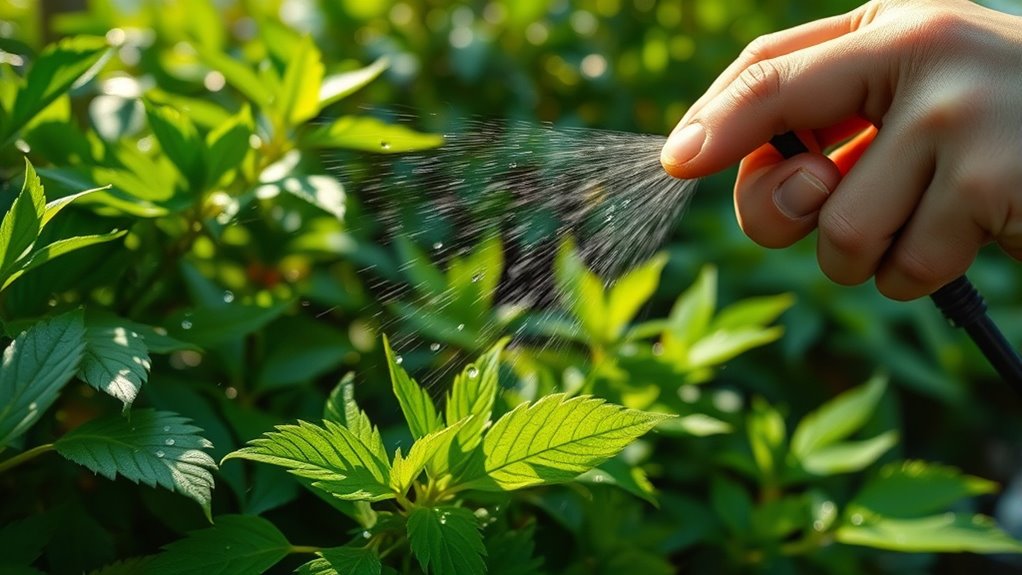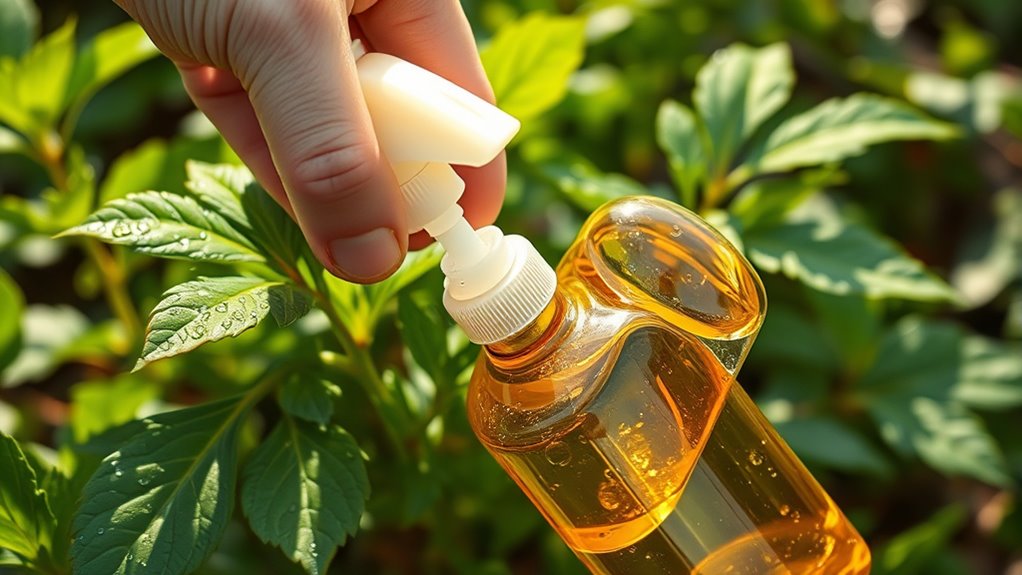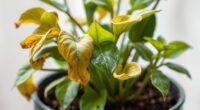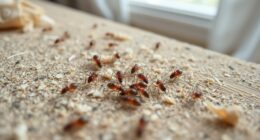To safely use neem oil on your plants, always follow the label instructions, dilute it with water and a mild soap, and test on a small area first. Spray during early morning or late afternoon to avoid leaf scorch and reapply every 7 to 14 days, especially after rain. Wear protective gear and avoid applying during peak sunlight or when pollinators are active. For more detailed tips on safe application, keep exploring.
Key Takeaways
- Always dilute neem oil with water and a surfactant, then test on a small plant area before full application.
- Spray early morning or late afternoon to avoid heat stress and maximize pest control effectiveness.
- Reapply every 7 to 14 days, especially after rain, and avoid spraying during peak sunlight to prevent leaf scorch.
- Wear protective gear, such as gloves and goggles, during mixing and spraying to ensure safety.
- Use neem oil responsibly, avoiding flowering plants during pollinator activity and not overusing to prevent plant stress.

Neem oil is a popular natural remedy for pest control and plant health, but using it safely is essential to avoid potential risks. If you’re into DIY pest control, neem oil offers an effective, eco-friendly option that aligns well with organic gardening principles. It’s a versatile solution that can help you tackle common pests like aphids, whiteflies, and spider mites without resorting to harsh chemicals. However, it’s crucial to understand how to apply it properly to protect your plants and yourself.
When using neem oil, always start by reading the label carefully. Concentrations can vary, and improper use may cause leaf burn or stress to your plants. To minimize risks, always dilute neem oil with water and a small amount of mild liquid soap or neem-specific surfactant. This helps the oil spread evenly and stick to plant surfaces, ensuring better pest control. Before applying it broadly, test the mixture on a small part of the plant to check for any adverse reactions. Wait 24 hours and observe for signs of damage or stress. If all looks well, you can proceed with a full spray.
Always dilute neem oil and test on a small plant area first to prevent damage.
Timing plays a vital role in safe neem oil application. Spray early in the morning or late in the afternoon, avoiding the heat of midday sun. This prevents leaf scorching and allows the oil to adhere better to pests and plant surfaces. Keep in mind that neem oil works best when pests are actively feeding, so regular monitoring and timely treatment are key. Reapply every 7 to 14 days or as needed, especially after rain, since water can wash off the oil. Additionally, understanding the importance of natural materials in organic gardening can help you make better choices for sustainable pest management.
In organic gardening, neem oil is valued for its natural origin and low environmental impact. But even with organic products, safety precautions matter. Wear gloves and eye protection during mixing and spraying to prevent irritation. Avoid applying neem oil to stressed or drought-stressed plants, as they are more susceptible to damage. Also, be cautious about applying neem oil to flowering plants if you’re concerned about pollinators; it can harm bees and butterflies. Early morning or evening sprays help mitigate this risk by reducing exposure to beneficial insects during peak activity times.
Frequently Asked Questions
Can Neem Oil Be Used on Edible Plants Safely?
You can safely use neem oil on edible plants if you follow proper guidelines. Always check for specific instructions regarding edible plant safety and avoid applying neem oil near harvest time to reduce residues. Applying it in the early morning or late evening minimizes residue buildup. Washing your produce thoroughly after treatment helps remove neem oil residues, ensuring your harvest is safe for consumption.
What Is the Best Time of Day to Apply Neem Oil?
You should apply neem oil early in the morning or late in the afternoon to optimize its effectiveness. Timing considerations are essential because environmental factors like sunlight and temperature can affect how well neem oil works and its safety for plants. Avoid applying during the hottest part of the day to prevent leaf burn and reduce stress on your plants, ensuring you get the best results while keeping your plants healthy.
How Often Should I Reapply Neem Oil on My Plants?
Imagine tending a delicate garden, knowing the right rhythm keeps pests at bay. For neem oil, follow the frequency guidelines: reapply every 7 to 14 days, depending on pest pressure. Reapplication tips include monitoring your plants closely and adjusting if you see new pests. Consistency matters—don’t overdo it, but don’t wait too long either. Keeping this balance guarantees your plants stay healthy and protected naturally.
Are There Any Plants That Should Avoid Neem Oil?
Some plants with sensitive foliage, like azaleas or succulents, should avoid neem oil because it can cause leaf damage. Additionally, neem oil may harm non-target insects, including beneficial pollinators and predators. If you’re unsure, test a small area first or avoid applying neem oil during flowering or in the heat of the day. Always follow recommended guidelines to protect your plants and the surrounding ecosystem.
Can Neem Oil Be Mixed With Other Pesticides or Fertilizers?
Think of your plants as a delicate symphony; adding too many ingredients can disrupt the harmony. Neem oil can generally be combined with certain pesticides and fertilizers, but you should check for pesticide compatibility and fertilizer mixing guidelines first. Always do a small test to prevent adverse reactions. This way, you guarantee your plants stay healthy and avoid unintended damage, keeping your garden thriving like a well-conducted orchestra.
Conclusion
Now that you know how to use neem oil safely, you’re well on your way to protecting your plants without risking harm. Remember, a little caution goes a long way—don’t bite off more than you can chew. With proper application, you’ll keep pests at bay and your garden thriving. Stay vigilant and treat your plants with care; after all, Rome wasn’t built in a day, and a healthy garden takes patience and attentiveness.









